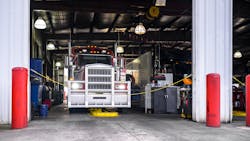Asset health checks help fleets make the right decisions
Much like annual physicals tell us about our general health, a checkup on each of our assets can tell us about the general condition and health of the assets. While it has always been important to keep up to date on the condition of assets, today’s supply-constrained environment makes it even more important.
Truck makers have dealers on allocations, so they are not getting the full number of vehicles they ordered which means fleets are also not getting all the trucks they needed to replace assets they had hoped to retire.
See also: Strategies for navigating supply chain disruptions
Every fleet manager is running some portion of their fleet beyond their typical replacement parameters. It’s no secret that older assets can be less efficient than their newer counterparts. In addition, as assets age, they often need more maintenance and repair. But not all a fleet’s older assets are in the same condition. Some may have more miles on them than others, some may have been operated by drivers who were mindful of hard braking and fast acceleration, some may have missed a PM service, the list goes on. In essence, no two assets, even if they are the same make/model/year, are exactly the same.
All fleets are going to have to continue to make decisions about which assets to run longer than they had intended, and from what I have been hearing, it is likely that allocations will continue into the next model year.
The decision on which of the older assets to keep and which to trade is one that will affect a fleet’s profitability. Choose the wrong asset and it could end up costing you a lot of money as well as leading to dissatisfied customers and drivers.
The best way to make a smart decision is to perform a health check on each asset. Begin by reviewing all the data you have on the asset especially its maintenance and repair history. Also note mileage or hours of operation, duty cycle, age, etc.
See also: Prolong asset life with a balanced approach
Next, bring each asset into the shop and do a thorough inspection looking for signs of trouble. Use the maintenance and repair history to determine if this is an asset worth keeping and, if so, fix any of the problems you discover during the inspection. This will help prevent on-road breakdowns.
The next step is to review existing PM schedules to see if they need to be altered based on the age and condition of the vehicle. A little extra attention could pay big dividends in terms of extending the life of an asset.
Finally, continue to monitor each asset, paying particular attention to the number of touches between PMs. That could be an indicator of developing problems or could mean you need to do a little refresher training on maintenance procedures.
While there is nothing we can do about supply chain constraints, we can take steps to ensure that we extend the life of the right assets.
Gino Fontana, CTP, is COO and EVP at Transervice Logistics Inc. Prior to this recent promotion, he was VP of operations at Berkeley Division and Puerto Rico. He has more than 35 years of experience in the transportation and logistics industry with both operational and sales experience.
About the Author
Gino Fontana
Chief operating officer and executive vice president at Transervice Logistics Inc.
Gino Fontana, CTP, is COO and EVP at Transervice Logistics Inc. His operational expertise emphasizes cost savings, process efficiency and improvement, superior quality, and people management skills. He has more than 35 years of experience in the transportation and logistics industry with both operational and sales experience.
